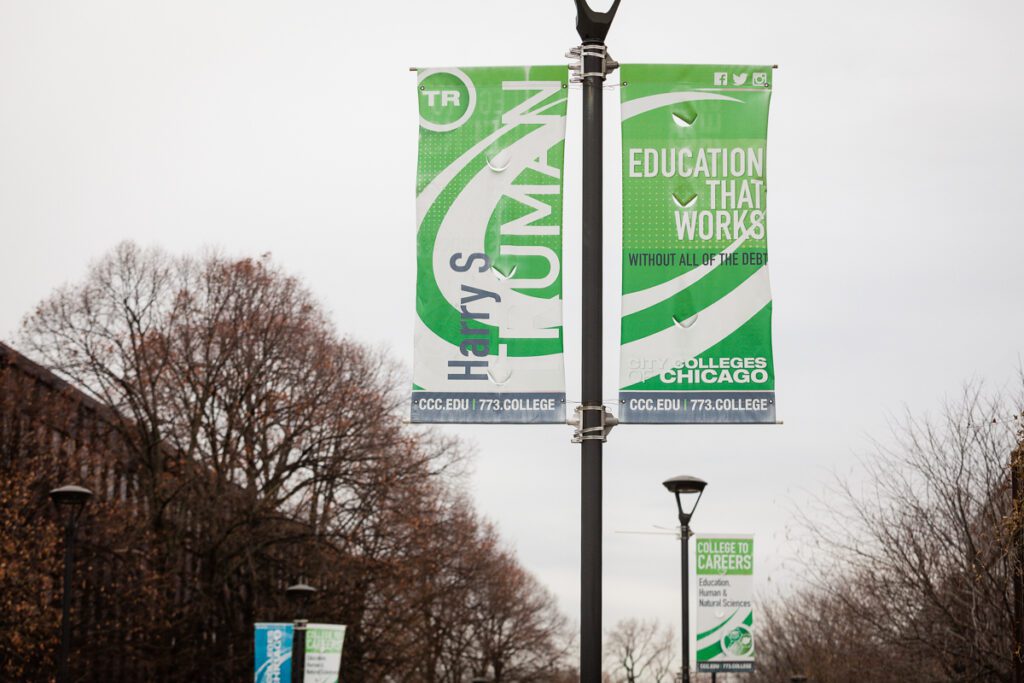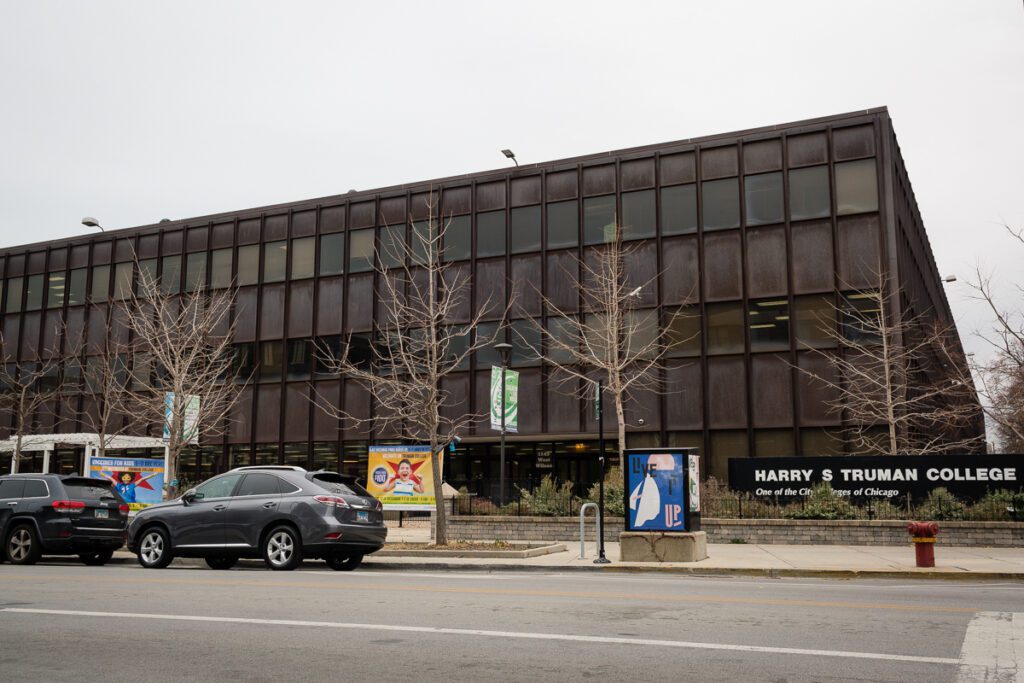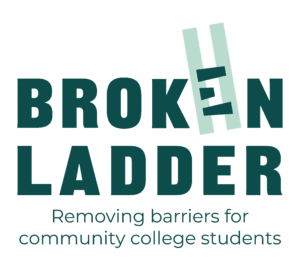 Fotografía de Michelle Kanaar/Borderless Magazine
Fotografía de Michelle Kanaar/Borderless MagazineLos estudiantes inmigrantes de los City Colleges of Chicago compaginan las horas de trabajo extra, los problemas tecnológicos y el dominio limitado del inglés con el aprendizaje a distancia.
Todos los martes y jueves a las 10.30 de la mañana, Lien Tang hace una pausa en su trabajo de asistenta a domicilio en Evanston y se concentra en su clase de inglés por Internet. Para entonces, ya se ha perdido las dos primeras horas del curso que toma a través de un colegio comunitario local. Si Tang, de 40 años, tiene suerte, su descanso coincide perfectamente con su turno para leer en voz alta a la clase. Si el profesor la llama en otro momento, pierde la oportunidad de participar.
"En persona es mejor porque vas allí, tienes que sentarte a estudiar. Pero [con las clases en línea] me limito a escuchar", dice Tang. "No puedo responder a la pregunta. Sólo escucho hablar al profesor o al compañero".
Noticias que ponen el poder en el punto de mira y a las comunidades en el centro.
Suscríbase a nuestro boletín gratuito y reciba actualizaciones dos veces por semana.
Estudiantes de todo Estados Unidos han tenido dificultades con el aprendizaje en línea durante la pandemia, ya que algunas familias tienen un acceso limitado o nulo a ordenadores e Internet o están poco familiarizadas con el correo electrónico o las herramientas de videoconferencia como Zoom. Para muchos estudiantes inmigrantes como Tang, que estudia en el Truman College de los City Colleges de Chicago, los obstáculos adicionales han hecho aún más difícil la novedosa experiencia. Muchos estudiantes han tenido que trabajar más horas para mantener a sus familias, al tiempo que se enfrentaban a problemas tecnológicos y hablaban un inglés limitado.
"Los inmigrantes a menudo se encuentran con nuevas instituciones por las que tienen que navegar, lo que generalmente presenta desafíos si no saben dónde o cómo acceder a los recursos, especialmente si no dominan el inglés", dijo Sophia Rodríguez, una ex profesora de ESL de Chicago que actualmente enseña en el Departamento de Enseñanza, Aprendizaje, Política y Desarrollo de la Universidad de Maryland. "Ahora hay una pandemia, que ya es un reto [de por sí] para quienes tienen recursos, conocimiento de las instituciones y privilegios. Los inmigrantes se enfrentan a múltiples retos, por lo que su prioridad puede ser simplemente intentar sobrevivir a esta pandemia."
Un reto único para los estudiantes
En todo el país, una proporción cada vez mayor de estudiantes de colegios comunitarios son inmigrantes cuya lengua materna no es el inglés. Tras llegar al país, estos estudiantes suelen tomar clases para mejorar su inglés, prepararse para los exámenes de ciudadanía o desarrollar una habilidad que les permita incorporarse al mercado laboral. Muchos eligen colegios comunitarios porque son más baratos que las universidades de cuatro años.
"[Los colegios comunitarios dan] a la gente acceso a alguna forma de educación superior que de otro modo no tendrían", dijo Rodríguez, que ha investigado sobre identidad étnica y educación urbana con estudiantes inmigrantes nativos y nacidos en el extranjero y con jóvenes refugiados.

En los City Colleges de Chicago, la proporción de estudiantes que se identifican como nacidos fuera de EE.UU. ha descendido del 17% al 13% en los últimos cinco años. Pero muchos siguen recurriendo al Programa de Educación de Adultos, que incluye clases de ESL sin créditos, cursos de GED y clases de preparación para la ciudadanía. Según Imran Mohammad Fazal Hoque, administrador estudiantil del CCC, alrededor del 90% de los alumnos del programa son inmigrantes recién llegados al país que no saben hablar inglés.
Las clases de ESL en Truman son gratuitas para todos los estudiantes e incluyen un curso de transición final que está destinado a preparar a los estudiantes para comenzar a tomar clases de crédito hacia su educación universitaria. CCC también trabaja con instituciones que sirven a los inmigrantes para proporcionar recursos y becas a inmigrantes como los beneficiarios de DACA que pueden no tener acceso a la ayuda financiera tradicional.
A raíz de la pandemia de COVID-19 en la primavera de 2020, CCC trasladó la mayor parte de sus clases a Internet. Entre ellos se encontraban las clases de inglés como segundo idioma, cuyos estudiantes "se vieron obligados a cambiar al aprendizaje virtual al tiempo que se enfrentaban a mayores preocupaciones sobre su empleo, su salud y su vivienda", explicó un portavoz de CCC a Borderless Magazine en un correo electrónico. Para facilitar la transición, la escuela proporcionó a los estudiantes "tecnología prestada, apoyo tecnológico, centros de bienestar para apoyo social/emocional, tutorías y mucho más".
Para muchos estudiantes inmigrantes, los cursos de los colegios comunitarios son algo más que aprender: son lugares donde construir una comunidad y obtener apoyo. En las escuelas medias y secundarias, los jóvenes inmigrantes pueden esperar construir una red de adultos de confianza, dijo Rodríguez. Pero una vez cumplidos los 18, encontrar y mantener ese apoyo puede resultar difícil.
En este nuevo entorno, los programas de ESL como los del CCC también pueden tener un impacto sustancial en el sentido de pertenencia social de los estudiantes.
"Eso puede ser muy poderoso porque es probable que se encuentren con barreras y retos similares", dijo Rodríguez. "En esos espacios en los que pueden reunirse para apoyarse -ya sea en un aula de ESL o en una comida organizada por una de esas oficinas en el colegio de la ciudad o en la universidad- pueden conocerse y ser una especie de recursos para los demás y compartir conocimientos".
La pérdida de ese espacio físico en favor de un mundo virtual de aprendizaje durante la pandemia, añadió, ha sido "desgarradora".
De los problemas técnicos al aprendizaje centrado en el alumno
Cuando las clases del programa de Aprendizaje de Adultos del CCC pasaron a ser virtuales el año pasado, muchos estudiantes adultos inmigrantes no sabían cómo utilizar o incluso acceder a su correo electrónico, dijo Hoque, que trabaja estrechamente con estudiantes inmigrantes en su papel de administrador y él mismo es un refugiado.
"Como las cosas cambiaban tan deprisa, no sabían cómo utilizar sus correos electrónicos [y] era la única forma que tenían de comunicarse con sus instructores. No sabían cómo hacerlo. No estaban preparados".
Tang recuerda haber tenido problemas para acceder a su cuenta de Zoom. Cada vez que intentaba entrar, recibía un mensaje de error que decía que su contraseña era incorrecta. Con un poco de ayuda de su hijo, que había utilizado Zoom en sus clases en línea de secundaria, fue capaz de recuperar su contraseña e iniciar sesión en su clase. Ella había recibido su Chromebook de préstamo gratuito de CCC sin ninguna complicación, pero dijo que algunos de sus amigos en el programa de ESL nunca recibieron sus ordenadores portátiles porque se perdieron en el correo.
Tang, que habla vietnamita, cantonés y mandarín, terminó el bachillerato y se licenció en contabilidad en Vietnam. Estaba ansiosa por empezar a aprender inglés y tomar "clases de inglés como cuarta lengua", como ella las llama. Se matriculó en Truman de CCC en 2016, un año después de emigrar a los EE. UU. En ese momento, trabajaba a tiempo parcial en un salón de manicura.
Durante la pandemia, para llegar a fin de mes, también empezó a trabajar como cuidadora de una anciana en Evanston a través de un programa de asistencia a domicilio de la Asociación Vietnamita de Illinois. Una de las ventajas de los cursos en línea es que le permiten seguir con su nuevo horario de trabajo.
"Tengo que ir a trabajar", dice Tang. "[Con las clases online], puedes hacer algo en casa o cuidar de tus hijos. Puedes trabajar".

Pero Tang echa de menos poder llevar sus tareas al profesor y resolver los problemas en tiempo real. Y si el profesor estaba ayudando a otra persona, a menudo resolvía problemas y preguntas con otros estudiantes. El mayor inconveniente para ella, sin embargo, es la limitada participación que tiene en el entorno en línea.
Matt Small, coordinador de alfabetización de adultos del VAI, dice que no le sorprende oír que la escasa participación es un problema en una clase de más de veinte alumnos.
Small, que imparte una clase de inglés a distancia a la que Tang asiste por las tardes además de su curso de Truman, dijo que las clases de aprendizaje de inglés de VAI tienden a ser pequeñas, con una matrícula que oscila entre tres y cinco estudiantes. Añadió que VAI sigue un modelo de enseñanza centrado en el alumno, en el que las acciones y la participación de los estudiantes, y no las del instructor, son el centro de atención.
"Una clase centrada en el estudiante con 20 ó 30 personas es factible en persona", afirma Small. "Es muy, muy difícil hacerlo en línea".
La naturaleza de las clases de inglés requiere a menudo una enseñanza táctil e interactiva, que no se da bien en los espacios virtuales. Además, dijo Rodríguez, el idioma se aprende en contexto, tanto dentro como fuera del aula.
"Así que su contexto [ahora] es su dormitorio, donde no interactúan con la gente. No van al supermercado, no van a repostar con sus padres", explica Rodríguez. "No tienen el tipo de experiencias cotidianas que les ayudan a integrarse y pertenecer a la comunidad local o a la cultura. Eso es terrible".
Soluciones impulsadas por los estudiantes
Mientras la pandemia y las clases virtuales se prolongan desde hace 21 meses, los estudiantes de los colegios comunitarios encuentran formas de adaptarse y conectarse en el entorno virtual.
Los instructores y el personal de CCC han intervenido para ayudar a los estudiantes de ESL, llegando incluso a llamar a los estudiantes para asegurarse de que eran capaces de iniciar sesión en sus clases, dijo un representante de CCC a Borderless Magazine en un comunicado. Los City Colleges también siguen prestando ordenadores portátiles a los estudiantes con buena conducta durante 60 días seguidos para que puedan completar sus cursos. Los estudiantes también pueden aprovechar el sistema de tutorías totalmente virtual e intercampus que se estableció durante la pandemia.

Más allá del sistema CCC, estudiantes como Hoque también han encontrado formas de cuidarse mutuamente.
Hoque, refugiado apátrida rohingya de Myanmar, estuvo detenido por las autoridades dos años en Indonesia y cinco en el centro de detención de inmigrantes off-shore de Australia, en Papúa Nueva Guinea. Aprendió por sí mismo a leer y escribir en inglés durante su segundo año de detención. En 2018, emigró a los Estados Unidos y más tarde se inscribió en el programa de Educación para Adultos de CCC.
"Tuve que empezar de cero", dice Hoque. "Obtuve mi diploma [de equivalencia] de secundaria en el departamento y luego hice la transición a la universidad".
El fideicomisario estudiantil, de 27 años, estudia ahora a tiempo parcial en el CCC y se graduará el próximo semestre con un título de asociado. También es presidente de la Sociedad de Honor Phi Theta Kappa de Truman College, la sociedad de honor oficial de las universidades de dos años de Estados Unidos.
Viendo la necesidad de más apoyo para los estudiantes inmigrantes como él durante la pandemia, Hoque organizó Phi Theta Kappa para empezar a prestar servicios a los inmigrantes. La sociedad ayuda ahora a los estudiantes inmigrantes a acceder a sus clases en línea y a saber cómo utilizar el correo electrónico para comunicarse con sus profesores. También ofrece servicios virtuales de tutoría sin cita previa y organiza actos para establecer contactos y talleres sobre becas.
Aunque no es lo mismo que el aprendizaje en persona o los eventos, los esfuerzos hablan de la realidad de que la pandemia COVID-19 y el aprendizaje en línea no terminarán pronto. Y con ello, los estudiantes inmigrantes tendrán que encontrar formas de superar muchos de los retos que la pandemia puso al descubierto.
"Al principio fue muy duro porque no sabíamos cómo iban a funcionar las cosas", dijo Hoque. "Pero... nuestra anterior normalidad ya no es normal. Esta virtualidad ya es normal".


